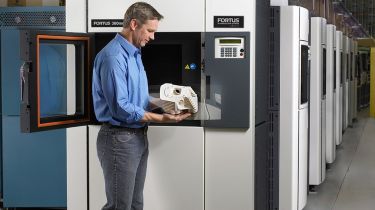3D printing: The future of the car industry?
We investigate how 3D printers are helping makers and motorists with car design and repairs
3D printing has been hailed as breakthrough technology that could lead to a second industrial revolution. The concept is simple enough: a machine – the 3D printer – is used to create an object according to the design from a computer file – in the same way a standard printer lays down words or pictures on a page from a document or image file.
But the potential uses of such technology are staggering – especially for the car industry and car owners. The way that cars and car parts are designed and made could be changed forever. So Auto Express decided to do some digging and discover just what effect 3D printing is having on the motoring industry.
First, let’s start with the science. The method employed in ‘printing’ a 3D part – and the material used – depends on the complexity and intended use of the finished object. At its most basic, 3D printing uses an additive process in which a spool of plastic the diameter of uncooked spaghetti is melted in a print head not dissimilar to a glue gun. The plastic is set down one wafer-thin layer at a time, before the printer lowers the print bed by roughly the width of a human hair and repeats the process for the next layer up.
Printers with multiple heads allow for greater flexibility. They can use different materials in each nozzle to, for example, build up a tail-light assembly in one piece, weave stronger brittle materials with weaker elastic elements for greater flexibility in bumpers, or use a water-soluble spacer material to pad out voids within an intricate structure. At the end of the process, the soluble parts are washed away to create overhanging, unsupported shapes that can wrap around existing components.
And it’s not only nylon and plastic that can be printed in this way. Replacement human jaws are already being printed in titanium, and at least two car manufacturers are using the process to develop future models. Ford is using it in the design of cars at its Technical Centre in Dunton, Essex, while KOR EcoLogic, which is based in Winnipeg, Canada, is readying its second-generation 3D printed car: the Urbee 2.
The first Urbee was custom printed using Fused Deposition Modelling – the spaghetti and glue gun approach – to create a honeycomb structure like a bee hive. This material was only used where necessary, giving a light, strong and green structure that performed well in a crash.
For the Urbee 2, all visible components inside and outside the vehicle will be printed in what KOR EcoLogic calls a factory of the future – a bank of printers working on 40 discreet panels, with ducting and wiring incorporated into each printed part. The metal roll cage and powertrain, which are hidden from sight, will still be produced in the traditional way.
Jim Kor, senior designer and head of the Urbee project, sees 3D printing, both at home and on the production line, as key to keeping the auto industry sustainable – particularly as we approach the world’s billionth car. And he’s starting to see broader take-up.
“I’ve read that any big change takes a generation,” he said. “Largely the young are the ones to fully embrace change and take progress forward. The less expensive, home 3D printers could be a sign of this happening today.”
One of those early adopters is Matthew Stonebraker, from Lafayette in Indiana, US. When the bonnet release broke on his partner’s car, sourcing a spare should have been easy. She drives a 2005 Buick LeSabre: a common four-door saloon with plenty of plastic parts – some obscure, others expensive.
“The parts are way marked up,” Matthew said. “She kicks the release all the time when going for the parking brake. It’s broken the plastic latching mechanism twice, but the cable’s fine.” No one would sell him less than the whole assembly, with plenty of parts he didn’t need. So he set out to build his own – and turned to 3D printing.
All Matthew needed were some careful measurements and widely available modelling software. He said: “I used the part geometry to model-up a reinforced version and had it printed by a company called Shapeways. It worked perfectly, and I couldn’t break it when I tried.”
The whole process took seven working days, and cost him just over $30 (£20). He’s since bought his own 3D printer, and estimates that producing the same piece on his dining room table would cost around a tenth of that price in raw materials, and take 18 hours to complete.
Shapeways – once part of electronics giant Philips – is an online 3D printing service, with offices in New York and Seattle in the US and Eindhoven in Holland. It lets customers like Matthew produce their own hard-to-find parts, bespoke gadgets, art – just about anything you could name – and sell them through its online shop.
While big manufacturers can afford more advanced kit, prices are already becoming more accessible. Entry-level printers start at under £1,000, and 3D scanners are coming on stream at similar prices.
Chester-based CADScan raised close to £100,000 via an online campaign to start production of just such a 3D scanner, which it hopes will make the operation as simple as using a regular photocopier. Prototype scanners are the size of a desktop inkjet printer, with a microwave-style rotating plate on which you place the part you want to replicate. They gauge all its angles, and build up a model in 3D for a printer to output.
It’s the kind of tool that would have made life easier for Matthew – as well as car customiser Todd Schlemmer. Todd, from Ballard, Seattle, wanted to replace his Toyota Prius’ original wheel caps. He measured the parts, recreated them in software and outsourced production to Shapeways.
But rather than follow Matthew by using the additive process, he opted for sintering – where nylon powder is fused into the required shape using a powerful laser.
“It’s an ideal material for this,” Todd explained. Toyota’s original wheel caps were secured using springs, which didn’t feature in his design, but sintering means “intricate detail can be created, and the inherent flexibility of the [fused nylon powder] positively snaps it in place. It’d be difficult to print these shapes on a typical consumer filament-fed 3D printer without additional and elaborate support elements”.
Todd now sells his bespoke wheel caps to other Prius owners, and says the process allows him to fulfil orders at similar prices to the factory parts. In the short term, 3D printing will enable us not only to save on repairs, as Matthew Stonebraker did, or to print custom parts like Todd Schlemmer, but to keep ageing classics running for longer. Armed with a 3D scanner and printer, we can replicate hard-to-find spares long after manufacturers have stopped producing them.
Beyond that, the possibilities are endless. The end could be in sight for centralised auto plants, with cars printed in the showroom, the driving seat designed to fit the customer’s inside leg, the steering wheel in perfect proportion to their grip – and all ready to be driven away a few hours after ordering.
The only limit is the motor industry’s imagination, and its will to push things forward.
Find a car with the experts



